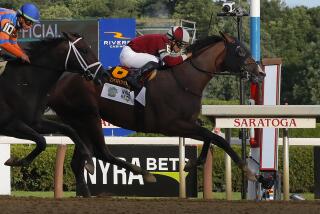HORSE RACING : Unsung Hero in Belmont Tragedy
- Share via
As unsung heroes go, Steve Erck ranks right up near the top.
Erck, a 43-year-old outrider for the New York Racing Assn., was at his post just past the finish line at Belmont Park last Saturday when Go For Wand broke down in the stretch of the Breeders’ Cup Distaff.
As quickly as his palomino quarter horse could carry him, Erck made a beeline for the stricken filly. His job, as it is every time a horse throws a jockey or falls, is to get the loose animal under control to prevent further havoc.
Erck desperately tried to grab Go For Wand’s bridle as she staggered across the track toward the outer rail. But the angle was awkward, and the badly limping filly was in a panic. That’s when Erck jumped.
“I could see I wasn’t going to get her from horseback,” said Erck, a former rodeo competitor. “The only chance I had to stop her was to get off and guide her down. I really didn’t have time to give it a second thought.”
It was truly an unbelievable sight: A 170-pound man with his arm wrapped around the neck of a 1,000-pound thoroughbred in the throes of shock. Using his best steer-wrestling techniques, Erck was able to ease Go For Wand to the ground and hold her there until help arrived.
“It’s kind of like judo,” Erck said. “I’m using her weight and her momentum to make her go where I want her to. Believe me, though, she was still fighting. If I had let her head go, she would have tried to get up again. That’s just instinct in these animals.”
Erck would not accept any suggestion of heroics on his part. With time-and-a-half overtime for the Breeders’ Cup program, Erck made $172 Saturday, a tough day’s wage if ever there was one. But he had done it before and, he knew, he would have to do it again.
“There’s always a chance a horse might be saved,” Erck said. “If that was the case, it was up to me to stop her before she ran into the rail, or something else, and caused even more damage to herself.
“By the time I got her down, it looked to me like she’d broken both legs. But I couldn’t really tell. All I saw was a lot of blood. And all the horse is thinking about is the pain--and getting it over with as soon as possible.”
Erck held Go For Wand’s head until the lethal injection of barbiturates took effect. Then, finally, he was able to relax his grip. An hour later, standing alongside his golden pony, Mikey, in the Belmont paddock, he reflected on the event.
“It’s the worst possible thing,” he said. “You never get used to it. Never. As far as I’m concerned, it’s a good day when all I have to do is lead them over and bring back the winner.”
In Boston, while Erck was cradling Go For Wand’s head in her dying moments, Dr. George Pratt was sitting in front of his television set, responding to the Distaff disaster with the anguish of any racing fan.
But Pratt is far from an ordinary horseplayer. In fact, the MIT engineering professor is one of only a handful of people in this country doing serious research in the area of equine bone stress and the safety of racing surfaces. Indeed, what Pratt does may someday help prevent another Go For Wand incident.
For more than a dozen years, Pratt has been working with race tracks around the country to develop optimum racing surfaces. His theories, which have been proven on running tracks for humans, hold that the safest surface also can be a very fast surface. But a track must be finely tuned; otherwise, it can add to the already enormous amounts of stress being placed on the thoroughbred leg.
To describe Belmont Park as “finely tuned” on Breeders’ Cup day would be stretching it. The weather was dry and clear, just as it had been three weeks earlier when Go For Wand had won the Beldame Stakes at the same distance. Yet, had she finished the Distaff, Go For Wand’s final time would have been 17 lengths slower than her time in the Beldame.
“I have no idea what’s going on in New York,” Pratt said, refusing to join the speculation over the safety of the Belmont Park surface. “But what any track needs is a cushion material with a low angle of internal friction.”
In other words, Pratt said, the deceleration of the hoof when it hits the ground should be made as gentle as possible by the content of the surface soil.
“When the hoof slides into the track and stops, that’s when you have the largest decelerations,” Pratt said. “They can be as large as 100 G’s.” That is, 100 times the force of gravity.
Furthermore, he noted, the speed of a horse’s stride can increase that G-force. It should come as no surprise, then, that the faster a horse runs, the greater the chance of injury.
“It appears we might have hit a barrier,” Pratt said. “We’ve made great improvements in muscle mass and the cardiovascular system, making greater speeds theoretically possible.
“But, in fact, horses are not running any faster than they were 30 years ago. And that’s because there have not been corresponding advances in the musculo-skeletal system. As a result, racehorses are becoming more susceptible to breakdowns.”
More to Read
Go beyond the scoreboard
Get the latest on L.A.'s teams in the daily Sports Report newsletter.
You may occasionally receive promotional content from the Los Angeles Times.










